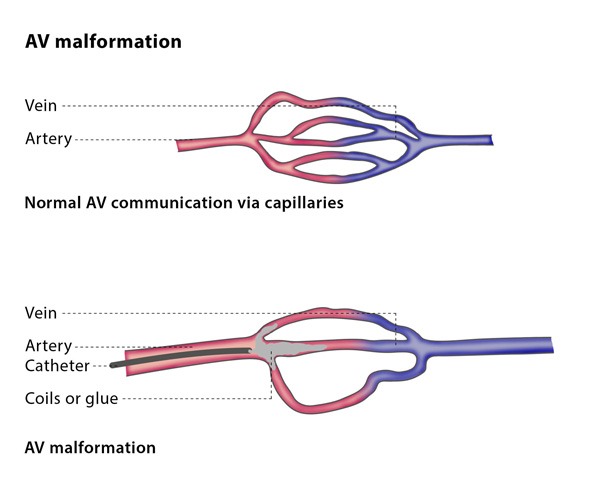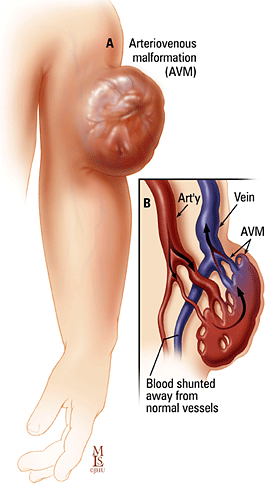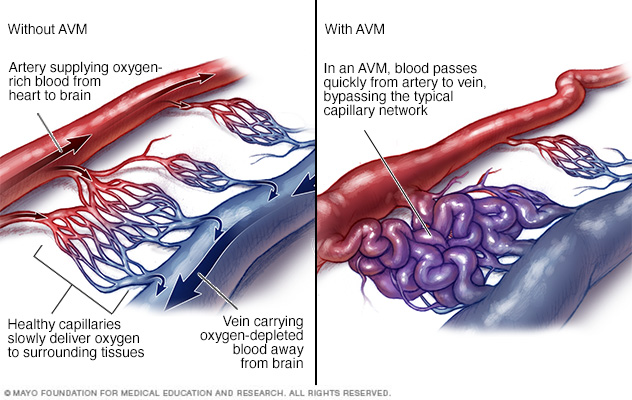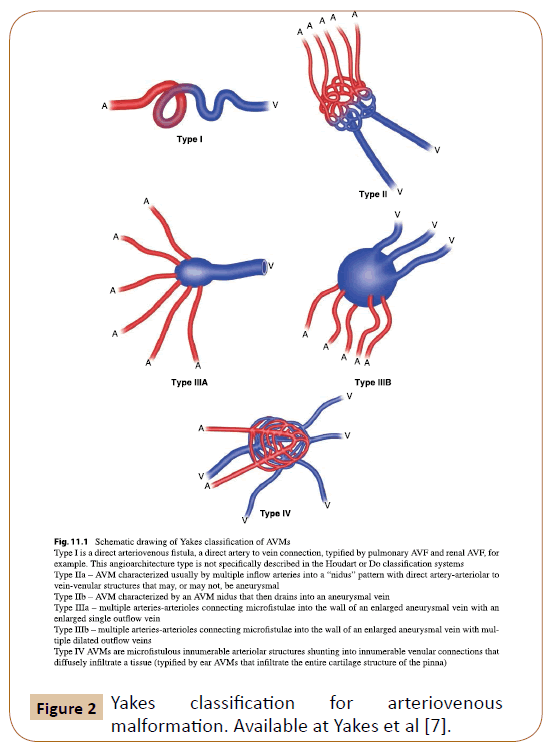Identify the Correct Statement Relating to an Arteriovenous Malformation.
Arteriovenous malformations are congenital and develop at birth. In AVMs arteries and veins are abnormally tangled.

Endovascular Treatment Of Arteriovenous Malformations Cirse
The veins enlarge as the flow increases.

. Embolic strokes are caused by. Blood flows from arteries to veins without going through capillaries. The arteries supplying the AVM tend to dilate with time as a result of increased flow through the lesion.
In the lesion there is no capillary bed which is part of normal tissue. Arteriovenous malformations are abnormal tangles of arteries and veins that belong to a group of disorders known as vascular malformations. Arteriovenous malformations AVMs are congenital lesions composed of a complex tangle of arteries and veins connected by one or more fistulae see the image below.
A malformation is an abnormal connection between the veins and arteries. When AVMs are located in the brain or spinal cord theyre called. AVMs can form anywhere in the body.
Arteriovenous malformations AVMs are abnormal connections between arteries and veins and are considered defects in the circulatory system. While they can theoretically occur anywhere in the body. Identify the correct statement relating to an arteriovenous malformation.
A transient neurological dysfunction caused by focal brain spinal cord or retinal ischemia. Creating a vicious cycle that can make this. Arteriovenous are malformation of the cerebrovascular system in which tortuous tangled and malformed arterial channels drain directly into the venous system without an intervening capillary bed.
An arteriovenous malformation AVM has a direct communication between arteries and veins ie. This in turn interferes with the normal blood circulation. During this procedure a harmless dye that can be seen on X-rays is injected into an.
Choose the correct statement relating to blood flow through an arteriovenous malformation. These malformations most often occur in the spinal cord and in any part of the brain or on its surface but can develop elsewhere in the body. It allows you to identify AVM from 2 cm in diameter and more but it is better to identify large and giant.
Arteriovenous malformations AVMs refer to the connection of arteries and veins without capillaries between them. The following tests may be used to diagnose your arteriovenous malformation AVM as well as help identify its size location and blood-flow pattern. Vessels of an AVM are very thin.
An arteriovenous malformation can take place anywhere in the body generally in the brain or spineAfter diagnosed AVM can often be treated successfully without difficulty or obstacles such as brain damage or strokeDepending on the location of Arteriovenous Malformations. Arteriovenous malformations AVMs are defects in the blood vessels of the circulatory system. One or more arteries feed into the AVM causing it to appear dilated and torturous Typically high-pressured arterial flow moves into the venous system through the connecting channels to increase venous.
This is the most common brain vascular malformation. Pulmonary arteriovenous malformations are abnormal direct connections between the pulmonary artery and pulmonary vein which result in a righttoleft shunt. Although not completely understood they typically develop in the womb or soon after birth and may be linked to genetic mutations.
It consists of a tangle of abnormal vessels connecting arteries and veins with no normal intervening brain tissue. The sensitivity of TCD in the diagnosis of arteriovenous malformations according to the described criterion is 895 with a specificity of 933 and error-freeness of 908. Identify the correct statement relating to an arteriovenous malformation.
It results in abnormalities which lead to tangling of arteries and veins. Occult or cryptic AVM or cavernous malformations. Fat air and blood clots.
Arteriovenous malformations are blood vessel defects that occur before birth when the fetus is growing in the uterus prenatal development. True arteriovenous malformation AVM. Blood is shunted directly from an artery to a vein without being utilized by the body Arteriovenous malformations are the least common vascular anomaly but are potentially the most troublesome because of the rapid flow of blood through the.
Overall they are rare in occurrence. The abnormal blood vessels result from feeding arteries directly connecting to a venous drainage system in the absence of a true capillary bed. Angiography This special X-ray exam shows the structure of a persons blood vessels and is essential in the diagnosis and treatment planning of AVMs.
Arteriovenous malformations AVMs happen when a group of blood vessels in your body forms incorrectly. This causes irregular connections between the arteries and veins. They most commonly occur in young adults with morbidity and death occurring in 3050 and 1015 of patients respectively.
In these malformations arteries and veins are unusually tangled and form direct connections bypassing normal tissues. But they most often occur in the spinal cord or brain. An Arteriovenous Malformation AVM is a cluster of unnatural blood vessels linking arteries and veins.
It goes directly from high atrial pressure to low venous pressure. They are associated with substantial morbidity and mortality mainly from the effects of paradoxical emboli. Brain arteriovenous malformations bAVMs are defects in the vascular system of the brain.
This usually happens during development before birth or shortly after. Arteriovenous malformation AVM is a vascular lesion that is a tangle of vessels of varying sizes in which there is one or more direct connections between the arterial and venous circulations. Arteriovenous malformations AVMs are abnormal snarled tangles of blood vessels that cause multiple irregular connections between the arteries and veins.
Potential complications include stroke cerebral abscess pulmonary. Arteriovenous malformations AVMs are groups of blood vessels in your body that form in the wrong way. The blood vessels appear as a tangled mass of arteries and veins.
The next non-invasive method of investigation is X-ray tomography. Brain AVMs have a prevalence range of around 10-18 per 100000 many of which remain asymptomatic.

Arteriovenous Malformations Avm Ucla Cerebrovascular Program Los Angeles Ca

Vascular Malformations Johns Hopkins Department Of Interventional Radiology

Arteriovenous Malformation Middlesex Health

Arteriovenous Malformation Concepts On Physiopathology And Treatment Insight Medical Publishing
0 Response to "Identify the Correct Statement Relating to an Arteriovenous Malformation."
Post a Comment